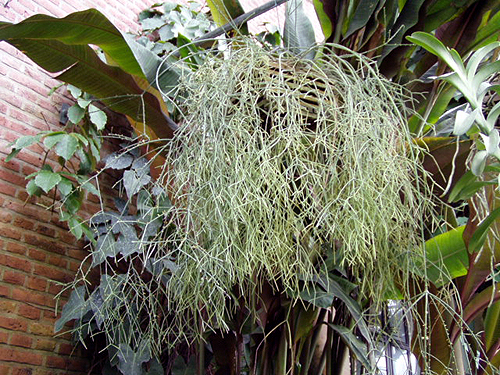Rhipsalis cassutha * Gaertner, Fruct. Sem. 1: 137. 1788.
R. cassutha, Leuven Botanic Garden, Leuven, Belgium © K
Friedman 9/2003 Treated as a synonym of Rhipsalis baccifera ssp. baccifera by B&T in Bradleya 13 Desc from B&R 1923, but as you can see it includes taxa from the old world that are excluded by B&T.
Rhipsalis cassutha * Gaertner, Fruct. Sem. 1: 137. 1788. Cassytha filiformis Miller, Gard. Dict. ed. 8. 1768. Not Linnaeus, 1753. Cactus parasiticus Lamarck, Encycl. 1: 541. 1783. Not Linnaeus, 1768. Cactus pendulus Swartz. Prodr. 77. 1788. Rhipsalis parasitica Haworth, Syn. Pl. Succ. 187. 1812. Cactus caripensis * Humboldt, Bonpland, and Kunth, Nov. Gen et Sp. 6: 66. 1823 Cereus caripensis De Candolle, Prodr. 3: 467. 1828. Rhipsalis cassytha dichotoma De Candolle, Prodr. 3: 476. 1828. Rhipsalis cassytha mauritiana** De Candolle, Prodr. 3: 476. 1828. Rhipsalis cassytha mociniana De Candolle, Prodr. 3: 476. 1828. Rhipsalis cassytha hookeriana De Candolle, Prodr. 3: 476. 1828. Rhipsalis cassytha swartziana De Candolle, Mem. Mus. Hist. Nat. Paris 17: 80. 1828 Rhipsalis dichotoma G. Don, Hist. Dichl. Pl. 3: 176. 1834. Rhipsalis hookeriana G. Don, Hist. Dichl. Pl. 3: 176. 1834. Rhipsalis cassythoides G. Don, Hist. Dichl. Pl. 3: 176. 1834. Rhipsalis cassutha pendula Salm-Dyck in Pfeiffer, Enum. Cact. 134. 1837 Rhipsalis undulata Pfeiffer, Enum. Cact. 136. 1837. Hariota cassytha Lemaire, Cact. Gen. Nov. Sp. 75. 1839. Cereus parasiticus Haworth in Steudel, Nom. ed. 2. 1. 335. 1840. Rhipsalis aethiopica Welwitsch, Journ. Linn. Soc. Bot. 3: 152. 1859. Rhipsalis minutiflora Schumann in Martius, FI. Bras. 4/2: 271. 1890. Hariota parasitica Kuntze, Rev. Gen. Pl. 1: 262. 1891. Rhipsalis comorensis Weber, Rev. Hort. 64: 424. 1892. Rhipsalis zanzibarica*** Weber, Rev. Hort. 64:425. 1892.
The fruit of Rhipsalis cassutha, while usually white, is sometimes described as red or pinkish. Hooker. in his Exotic Flora, figured and described the fruit as flesh-colored. Weber, who received a red-fruited form from Costa Rica, has named it variety rhodocarpa (Dict. Hort. Bois 1046. 1898). In the West Indies the plants inhabit moist districts and are most abundant in forests, but in the vicinity of Matanzas, Cuba, occur on cliffs.
*This name was written Cactus garipensis by Kunth (Syn. Pl. Aeq. 3: 370. 1824) and is so listed i:n the Index Kewensis. **De Candolle gives Cactus pendulinus Sieber (Fl. Maur. 2. n. 259) as a synonym of this variety ***Schumann (Gesamtb. Kakteen 623) spells the name Rhipsalis sansibarica. |
